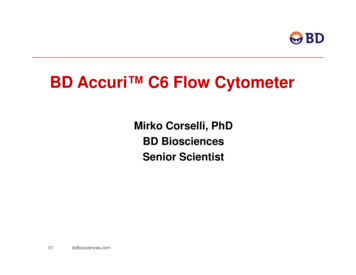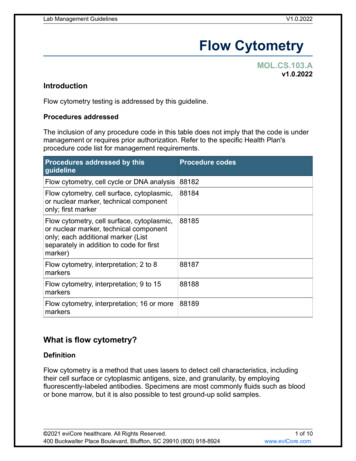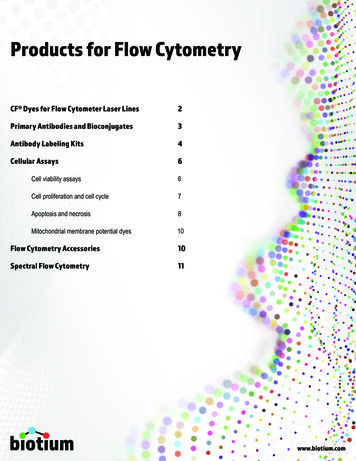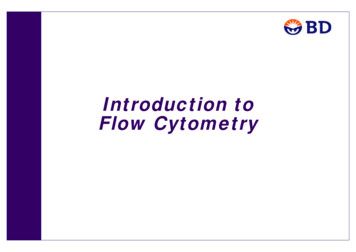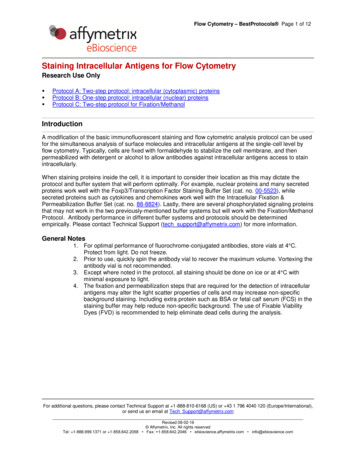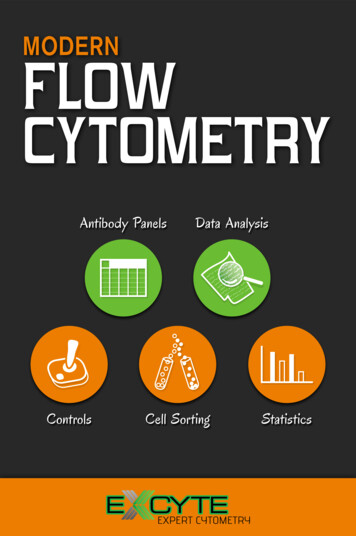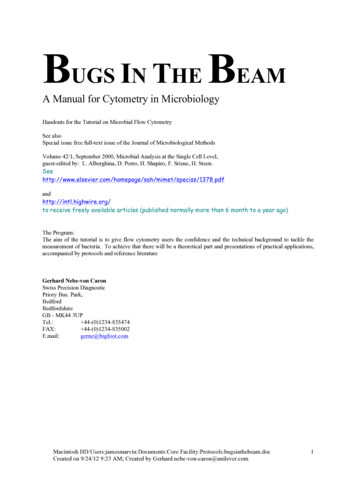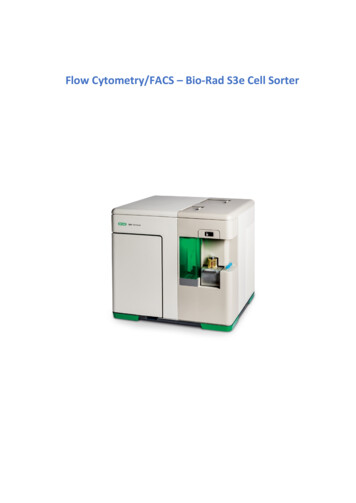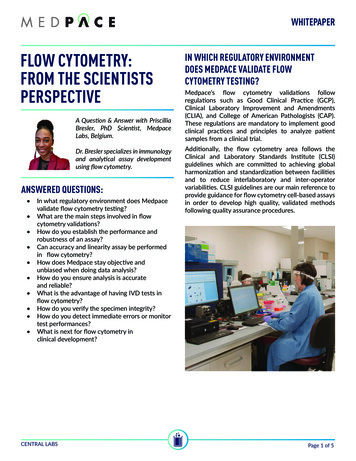
Transcription
WHITEPAPERFLOW CYTOMETRY:FROM THE SCIENTISTSPERSPECTIVEA Question & Answer with PriscilliaBresler, PhD Scientist, MedpaceLabs, Belgium.Dr. Bresler specializes in immunologyand analytical assay developmentusing flow cytometry.ANSWERED QUESTIONS: In what regulatory environment does Medpacevalidate flow cytometry testing?What are the main steps involved in flowcytometry validations?How do you establish the performance androbustness of an assay?Can accuracy and linearity assay be performedin flow cytometry?How does Medpace stay objective andunbiased when doing data analysis?How do you ensure analysis is accurateand reliable?What is the advantage of having IVD tests inflow cytometry?How do you verify the specimen integrity?How do you detect immediate errors or monitortest performances?What is next for flow cytometry inclinical development?CENTRAL LABSIN WHICH REGULATORY ENVIRONMENTDOES MEDPACE VALIDATE FLOWCYTOMETRY TESTING?Medpace’s flow cytometry validations followregulations such as Good Clinical Practice (GCP),Clinical Laboratory Improvement and Amendments(CLIA), and College of American Pathologists (CAP).These regulations are mandatory to implement goodclinical practices and principles to analyze patientsamples from a clinical trial.Additionally, the flow cytometry area follows theClinical and Laboratory Standards Institute (CLSI)guidelines which are committed to achieving globalharmonization and standardization between facilitiesand to reduce interlaboratory and inter-operatorvariabilities. CLSI guidelines are our main reference toprovide guidance for flow cytometry cell-based assaysin order to develop high quality, validated methodsfollowing quality assurance procedures.Page 1 of 5
WHAT ARE THE MAIN STEPS INVOLVED INFLOW CYTOMETRY VALIDATIONS?HOW DO YOU ESTABLISH THE PERFORMANCEAND ROBUSTNESS OF AN ASSAY?Most flow cytometry assays are cell-based assaysand are considered to be Laboratory DevelopedTests (LDTs). They must be optimized and developedto meet Quality Assurances requirements. Medpacemostly uses flow cytometry in exploratory endpointsusing Research Use Only (RUO) products, but the flowcytometry technique can also be used as a patientinclusion or exclusion criteria.Performance: Methods used to establish theperformance of an assay include precision, stability,analytical measuring range, and reference ranges.Before starting the validation of a cell-based flowcytometry assay, the scientist needs to understandthe objective of the assay, how the assay is tobe implemented, and what the best method is toprovide trustworthy results to the sponsor for theirclinical trial.Precision can be measure in two ways:1. Variation between separate runs (inter-runprecision or reproducibility)2. Variation within a run (repeatability)A flow cytometry validation includes assayoptimization and assay characterization: Assay optimization includes the titration of theantibody and the creation of the assay on theinstrument (including compensation and thespill over values).Assay characterization is performed todetermine if the assay is fit for the intendeduse. The characterization includes precision,stability, instrument carry-over and analyticalmeasuring range of the assay.Precision: The precision establishes the degree ofagreement among test results when the procedureis applied in a repeated manner to one or multiplestained specimens. The precision confirms if the assayyields reproducible results with precise measurement.Three parameters can induce variability inassay results:1. The biological variation between samples2. Instrument fluctuation3. Sample processing by different operatorsTherefore, multiple samples and operators are usedduring reproducibility.Stability: The stability is defined by the time pointwhereby the sample does not have a significant loss ofthe property or the integrity of a measurand comparedto the baseline. The effect of shipping conditions,shipping delays, short- or long-term cryopreservationof a specimen, and the effect of processing delay(time between the staining and acquisition) mustbe evaluated in the stability section of the initialvalidation plan.Analytical measuring range (AMR): The sensitivity ofan assay is determined by the lowest reportable resultsof a specific measurement. The sensitivity includes theLimit of Detection (LOD), the Limit of Blank (LOB) andthe Lower Limit of Quantitation (LLOQ).For quasi-quantitative assays, the analytical sensitivityincludes LOD, LOB and LLOQ. The LOB is the highestsignal that can be measured by the instrument in theabsence of the measurand and can be assessed byusing Florescence Minus One (FMO) control tube.The LOD is related to the LOB and is defined asthe lowest concentration of measured that can bedetected by the instrument but not quantified.The LLOQ is the lowest level of measurand that can bedetected by the instrument with an acceptable criteriaof 30% to 35% Coefficient of Variation (CV) For cell-CENTRAL LABSPage 2 of 5
based assay like flow cytometry, the approach is tocreate samples near the LLOQ through serial dilutionsof stained specimens into unstained specimens. TheLLOQ maybe equal but never lower than the LOD.Reference Ranges: Reference ranges are the limits(minimum and maximum) of the distribution for ameasurands. Reference ranges are usually used todiagnostic abnormal populations and to flag criticalvalues on laboratory reports. In flow cytometry,references ranges can be used in IVD tests such asTBNK assay, except if the population in normallyabsent in healthy donors. In LDTs, reference intervalsare not always available or appropriate if we considerthe complexity of the qualitative multiparametricanalysis.Robustness: The robustness of an assay is thecapacity of a defined method to remain unaffected bydeliberated changes. We address the robustness of anassay by analyzing the same sample using a differentantibody lot to determine the variability between bothlots. During the reproducibility we start up and shutdown the instrument and run the performance checkof the instrument before doing a second run andanalyzing the variability between two runs.CAN ACCURACY AND LINEARITY ASSAY BEPERFORMED IN FLOW CYTOMETRY?A flow cytometry cell-based assay includes severalcomponents including the fluorochromes (typeand number), the lasers, the type/configuration ofinstruments, reagents, cellular targets and type, andthe stability of the specimen. These parameters canvary and expend depending on the assay. Therefore,using flow cytometry to design and validate an assayincluding all these components is challenging. Forthese reasons, we cannot apply all the same methodsused to establish the performance of an assay asin chemistry or hematology because of the lack ofreference materials with known values. Among themethods that cannot always be evaluated there istesting for accuracy and the linearity.Accuracy: The accuracy is the degree of agreementbetween a measured quantitative value and the trueknown quantitative value. The accuracy is assessed bycalculating the bias between the standard referencematerial with defined target values and the measuredvalue obtained by the laboratory.Example: It is extremely challenging to determine theaccurate expression level of a specific cell-surface(CD45) or intracellular marker (FoxP3) because thetrue known standard reference material for thisspecific marker in the appropriate specimen typeis not available. For specific IVD assays, we can findcommercial QC samples and run accuracy, howeverthe known reference ranges are broad, so eachlaboratory needs to establish its own range for assayacceptance criteria.Linearity: The linearity of an analytical methodis the capability to show results proportional tothe concentration of analyte in a sample, within agiven range. Linearity cannot be assessed without acalibration curve and is only applicable for quantitativemethods. In quantitative analytical methods suchas hematology or chemistry, we can establish thelinearity of the analyte where a mathematically verifiedrelationship between the observed values and the trueconcentrations of the analyte can be determined.In the case of flow cytometry, most of the resultsgenerated are quasi-quantitative or qualitative innature. The reportable results obtained from a flowcytometry assay are usually expressed as a percentageof a specific population of cells, the number of cells perµ or the Mean Fluorescence Intensity (MFI). Therefore,linearity cannot always be assessed.CENTRAL LABSPage 3 of 5
However, the Receptor Occupancy (RO) assay is theonly category of flow cytometric assay in which thelinearity must be evaluated. RO assay describes therelationship between the drug and its target, then, wecan use the drug as a reference standard with knownconcentrations. Usually we assess the linearity of theRO assay using healthy donor samples pre-incubatedex vitro with known drug concentrations from a full topartial saturation of the targeted receptor.HOW DOES MEDPACE STAY OBJECTIVE ANDUNBIASED WHEN DOING DATA ANALYSIS?Being biased in flow cytometry is something to avoidat all cost. Therefore, we have to implement severalcontrols in flow cytometry assays to stay objectivewhen performing an analysis.First we can define a good gating strategy to excludedebris, dead cells, doublets and fluidic instability asthey promote the occurrence of nonspecific events.Additionally, during the initial validation it is crucial tomake sure that no carryover is detected.When performing deep analysis for an official datatransfer, it is important for the Scientist to staytransparent and communicate with the sponsor toreach a consensus about the gating strategy. It ishighly recommended to share the baseline timepointfor sponsor approval. This baseline gating can beapplied to the future timepoints and any changes canbe mentioned in the final report for sponsor review.Secondly, we include FMO (fluorescence minusone), isotypes or internal controls. For instance, byusing an FMO condition we are staining a definedsample without the antibody of interest. The negativepopulation as defined based on the FMO conditionsused as a negative control. Applying this FMO gatingstrategy on a fully stained sample allows us to betterdefine, without any subjectivity, positive cells forthis marker.The use of isotype control can be implemented aswell. Isotype controls are conjugated immunoglobulinantibodies from the same species but with an irrelevantspecificity. Isotype controls allow us to detect andexclude the presence of nonspecific binding duringassay optimization and data analysis. However, thedisadvantage of using an isotype control is that theydo not contain the same fluorescence-to-protein ratioas the primary antibody.CENTRAL LABSFinally, another method is to include an internalnegative control, such as a population that is knownto not express the antigen of interest. However, itis better to use a population that shows the sameautofluorescence as the population of interest.HOW DO YOU ENSURE THE ANALYSIS ISACCURATE AND RELIABLE?Before performing flow cytometry analysis, we needto assess the performance of the cytometer before anyacquisition using Cytometer Setup and Tracking beads(CS&T). Moreover, the maintenance of the instrument(cleaning, preventive maintenance) needs to be doneregularly and documented. After each compensation(baseline, preventive maintenance) adjustment, thePhD scientist validates the new compensations byfollowing a set of defined acceptance criteria.The reliability of an analysis is based on the properusage of antibodies as well. Each time a new antibodyis used, the PhD scientist needs to make sure thatthe bias between the old and new lot is acceptable.Importantly, every operator processing samples mustbe properly trained. The PhD scientist ensures that thebias between the trainer and the trained operator isacceptable to process clinical patient samples. As flowcytometry samples are extremely precious, after eachsample acquisition, the PhD scientist analyzes andreviews flow cytometry data to provide high qualityresults to the sponsor. If necessary, the PhD scientistcan ask for selected samples to be rerun or analyzed,should there be potential discrepancies.WHAT IS THE ADVANTAGE OF HAVING IVDTESTS IN FLOW CYTOMETRY?In Vitro Diagnostics (IVD) tests are extremely usefulin flow cytometry as we are using reagents suchas antibody cocktails approved by the Food DrugAdministration (FDA). FDA approvals ensure that IVDtests provide consistent results and can be used forprimary endpoint clinical trials. IVD tests are less timeconsuming, less prone to errors compared to LDTs.Moreover, IVD tests provide accuracy and reliableresults because of the utilization of QC materials.Page 4 of 5
HOW DO YOU VERIFY THESPECIMEN INTEGRITY?WHAT IS NEXT FOR FLOW CYTOMETRY INCLINICAL DEVELOPMENT?In flow cytometry we are frequently using preciousand sensitive samples with short stability; therefore,during the initial validation of the assay, the stabilitybefore and after sample processing (staining) has to beevaluated to have an idea of the acceptable timeframein which a sample can be either stored or analyzed.Each time a patient sample is received, the specimenintegrity will be verified by visually inspecting for thepresence of a clot or hemolysis. Moreover, we makesure to process the sample as quickly as possible afterreception in the laboratory to start the processingwithin the stability window defined during the initialvalidation. We make sure to include a live/dead dye inthe flow cytometry panels to exclude debris and deadcells in the analysis because these components canlead to non-specific binding.Flow cytometry is a well-known technique that canbe used to complement other techniques and areassuch as ELISA or molecular biology. In 10 years, wecan imagine the clinical pipeline embarked by a singlefresh whole blood patient sample starting from twoassays performed by flow cytometry.HOW DO YOU DETECT IMMEDIATE ERRORS ORMONITOR TEST PERFORMANCES?Each time an assay is validated, the precision (withinrun and between run imprecision) is performed toaddress the performance and the robustness ofthe assay.For flow cytometry IVD assays (non-LDTs), we includeQuality Control materials to ensure the reliability andperformance of the assay. The QC material is similar tothe specimen matrix but with a longer shelf life.For LDTs, QC material does not exist. One option is touse in-house QC materials such as positive controls(cell lines, activated PBMCs) or commercializedlyophilized cells. Each time a sample is acquired, anin-house QC material can be run before or after tovalidate the assay performance.The first assay will be an immunophenotyping assayand the second will be to use Fluorescent ActivatedCell Sorter to sort for specific cell subsets for genomictesting by the molecular biology area. The ELISA teamwill then take the plasma of this sample and performa multiplex cytokine analysis using the MesoscaleDiscovery technique. The collaboration of scientistsfrom three different platforms increases the dataoutput from one single patient sample.FULL-SERVICE CLINICAL DEVELOPMENTMedpace is a scientifically-driven, global, fullservice clinical contract research organization (CRO)providing Phase I-IV clinical development servicesto the biotechnology, pharmaceutical and medicaldevice industries. Medpace’s mission is to acceleratethe global development of safe and effective medicaltherapeutics through its high-science and disciplinedoperating approach that leverages local regulatoryand deep therapeutic expertise across all major areasincluding oncology, cardiology, metabolic disease,endocrinology, central nervous system and anti-viraland anti-infective.An alternative procedure is to test duplicatedspecimen. Each replicate will be run by two differentoperators with a different mixture of antibody andthen reviewed by the scientist. The consistencybetween both analyses will highly validate the testperformance.Finally, the PhD scientist check immediate errorsby reviewing data immediately after processing andacquisition so that it can be repeated or correctedif necessary.MRL-0018-1021
mostly uses flow cytometry in exploratory endpoints using Research Use Only (RUO) products, but the flow cytometry technique can also be used as a patient-inclusion or exclusion criteria. Before starting the validation of a cell-based flow cytometry assay, the scientist needs to understand the objective of the assay, how the assay is to


